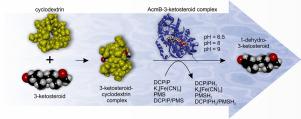The Journal of Steroid Biochemistry and Molecular Biology ( IF 2.7 ) Pub Date : 2020-08-07 , DOI: 10.1016/j.jsbmb.2020.105731 Agnieszka M Wojtkiewicz 1 , Patrycja Wójcik 1 , Magdalena Procner 1 , Monika Flejszar 2 , Maria Oszajca 3 , Mateusz Hochołowski 1 , Mateusz Tataruch 1 , Beata Mrugała 1 , Tomasz Janeczko 4 , Maciej Szaleniec 1

|
Cholest-4-en-3-one Δ1-dehydrogenase (AcmB) from Sterolibacterium denitrificans, a key enzyme of the central degradation pathway of cholesterol, is a protein catalyzing Δ1-dehydrogenation of a wide range of 3-ketosteroids. In this study, we demonstrate the application of AcmB in the synthesis of 1-dehydro-3-ketosteroids and investigate the influence of reaction conditions on the catalytic performance of the enzyme. The recombinant AcmB expressed in E. coli BL21(DE3)Magic exhibits a broad pH optimum and pH stability in the range of 6.5 to 9.0. The activity-based pH optimum of AcmB reaction depends on the type of electron acceptor (2,6-dichloroindophenol - DCPIP, phenazine methosulfate - PMS or potassium hexacyanoferrate - K3[Fe(CN)6]) used in the biocatalytic process yielding the best kinetic properties for the reaction with a DCPIP/PMS mixture (kcat/Km = 1.4·105 s-1·M-1 at pH 9.0) followed by DCPIP (kcat/Km = 1.0·105 s-1·M-1 pH = 6.5) and K3[Fe(CN)6] (kcat/Km = 0.5·102 s-1·M-1 pH = 8.0). The unique feature of AcmB is its capability to convert both testosterone derivatives (C20-C22) as well as steroids substituted at C17 (C27-C30) such as cholest-4-en-3-one or (25R)-spirost-4-en-3-one (diosgenone). Apparent steady-state kinetic parameters were determined for both groups of AcmB substrates. In a batch reactor synthesis, the solubility of water-insoluble steroids was facilitated by the addition of a solubilizer, 2-hydroxypropyl-β-cyclodextrin, and organic co-solvent, 2-methoxyethanol. Catalytic properties characterization of AcmB was tested in fed-batch reactor set-ups, using 0.81 µM of isolated enzyme, PMS and anaerobic atmosphere resulting in >99% conversion of the C17-C20 3-ketosteroids within 2 h. Finally, the whole-cell E. coli system with recombinant enzyme was demonstrated as an efficient biocatalyst in the synthesis of 1-dehydro-3-ketosteroids.
中文翻译:

通过反硝化斯特雷氏菌的3-酮类固醇脱氢酶在宽pH范围内有效地对3-酮类固醇进行有效的Δ1-脱氢。
胆甾-4-烯-3-酮Δ 1从Sterolibacterium脱氮脱氢酶(ACMB),胆固醇的中央降解途径的关键酶,是一种蛋白质催化Δ 1的宽范围的3-酮类固醇的-dehydrogenation。在这项研究中,我们证明了AcmB在1-dehydro-3-ketosteroids合成中的应用,并研究了反应条件对酶催化性能的影响。在大肠杆菌BL21(DE3)Magic中表达的重组AcmB在6.5至9.0的范围内表现出广泛的pH最佳值和pH稳定性。AcmB反应基于活性的最佳pH值取决于电子受体的类型(2,6-二氯吲哚酚-DCPIP,吩嗪硫酸甲酯-PMS或六氰合铁酸钾-K 3 [Fe(CN)6])用于生物催化过程,与DCPIP / PMS混合物(k cat / K m = 1.4·10 5 s -1 ·M -1在pH 9.0下)反应产生最佳动力学性能,然后与DCPIP(k cat / K m = 1.0·10 5 s -1 ·M -1 pH = 6.5)和K 3 [Fe(CN)6 ](k cat / K m = 0.5·10 2 s -1 ·M -1pH = 8.0)。AcmB的独特之处在于它既能够转化睾丸激素衍生物(C20-C22),也可以转化在C17(C27-C30)处取代的类固醇,例如胆甾4-烯-3-酮或(25R)-螺骨-4- en-3-one(diosgenone)。确定两组AcmB底物的表观稳态动力学参数。在间歇反应器合成中,通过添加增溶剂2-羟丙基-β-环糊精和有机助溶剂2-甲氧基乙醇来促进水不溶性类固醇的溶解性。AcmB的催化性能表征已在分批进料反应器设置中进行了测试,使用0.81 µM的分离酶,PMS和厌氧气氛在2小时内使C17-C20 3-酮类固醇转化率> 99%。最后是全细胞E。











































 京公网安备 11010802027423号
京公网安备 11010802027423号